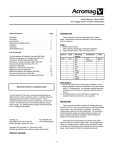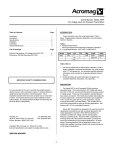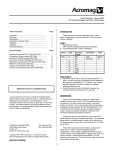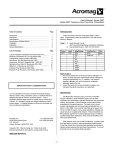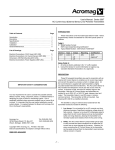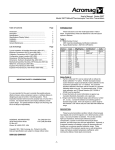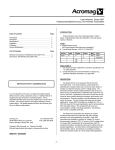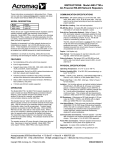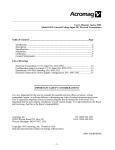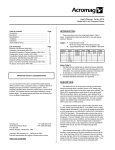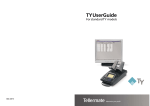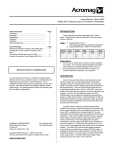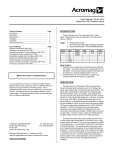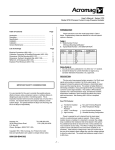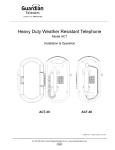Download - 1 - User`s Manual: Series 250T AC Current Input
Transcript
User's Manual: Series 250T AC Current Input (External Sensor) Two-Wire Transmitters Table of Contents Page Introduction Description Specifications Specifications (Display Option) Installation Calibration General Maintenance INTRODUCTION: These instructions cover the model types listed in Table 1 below. Supplementary sheets are attached for units with special options or features. 1 1 2 4 4 6 6 Table 1: A. Model Number Format: 1 250T-Input-Mounting/Display-Certification 1 B. Typical Model Number: 250T-CACX-XPD1-NCR List of Drawings Typical Installation & Simplified Schematic (4501-383) Electrical Connections: CACX Input (4501-377) Electrical Connections: AC Current Sensor (4501-380) Dimensions: DIN Rail Mounting (4501-080) Dimensions: Surface & Snaptrack Mounting (4501-081) Mechanical Assembly: Mounting -XP & -4X Enclosures (4501-082) NEMA 4 & 12 Enclosures (4501-083) NEMA 4X Enclosure (4501-086) NEMA 4X Enclosure, with Window (4501-087) Explosion Proof Enclosure (4501-084) Explosion Proof Enclosure, with Window (4501-085) Series 250T 7 8 9 10 11 12 13 14 15 16 17 -Mounting/Display -DIN -SM -ST -N4 -N12 -4X -4XD1 -4XD2 -4XD3 -XP -XPD1 -XPD2 -XPD3 -Certification -NCR 2 -Approval Notes (Table 1): 1. All units are factory calibrated (no “-C” suffix is needed). 2. Consult the factory for current information on agency (e.g. Canadian Standards Association, etc.) approvals. IMPORTANT SAFETY CONSIDERATIONS DESCRIPTION: It is very important for the user to consider the possible adverse effects of power, wiring, component, sensor, or software failures in designing any type of control or monitoring system. This is especially important where economic property loss or human life is involved. It is important that the user employ satisfactory overall system design. It is agreed between the Buyer and Acromag, that this is the Buyer's responsibility. Acromag, Inc. 30765 Wixom Road, P.O. Box 437 Wixom, Michigan 48393-7037, USA -Input -CACX These two-wire transmitters are used in conjunction with an external AC Current Sensor to condition an AC current input signal and convert this signal to a 4 to 20mA process current output. An AC Current Sensor is supplied with each transmitter (a highly accurate toroidal instrument transformer). The AC Current Sensor is fully insulated and designed to mount near the source of the AC current. It transmits a safe, low-level DC milliamp signal to the transmitter. Both the AC Current Sensor and transmitter are isolated for up to 250V AC, or 345V DC peak, between input and output. The transmitters are RFI-protected, operate over a wide temperature range, and feature excellent temperature coefficients, which minimize effects from the harsh plant environment. The transmitter has various mounting and enclosure options available. See Drawing 4501-383 for a simplified schematic. Tel: (248) 624-1541 FAX: (248) 624-9234 Copyright 1994, Acromag, Inc., Printed in the USA. Data and specifications are subject to change without notice 8500-501-A94A000 -1- Series 250T User's Manual AC Current Input (External Sensor) Two-Wire Transmitter ___________________________________________________________________________________________ SPECIFICATIONS: Following basic two-wire design, the output and the DC power share the same pair of twisted copper wires. The transmitter acts similar to a variable resistor in series with the load and DC supply and provides an output loop current proportional to the input sensor signal. See Drawing 4501-383 for a typical installation. Function: This family of isolated two-wire transmitters utilize an external AC Current Sensor to condition an AC current input signal and convert this signal to a 4 to 20mA process current output. The sensor is designed to be field-mounted near the AC current it is measuring and transmits a low level DC milliamp signal to the transmitter’s input. The sensor and transmitter are each isolated between input and output. Transmitter zero and span adjustments utilize 22-turn potentiometers accessible from the front of the unit. This transmitter has various mounting and enclosure options available . The benefits to using an external sensor (external from the transmitter enclosure) include the following: 1. Low losses: It is not practical to run AC currents over long distances because of significant resistance voltage drops at high currents. However, a low level DC milliampere signal is output from the AC Current Sensor and can be transmitted safely over long distances, allowing the transmitter to be remotely located some distance from the AC power wiring. MODEL/SERIES: 250T- (Color Coded with a White Label) 2. Safety: The AC Current Sensor's output leads can be open or short circuited and these conditions do not affect the AC current loop or cause damage to the sensor. Likewise, the wires connecting the AC Current Sensor to the transmitter can be easily removed from the transmitter's input terminals without concern or hazard. INPUT (Sensor and Transmitter): AC Current Sensor (5020-350): One sensor is supplied with each Model 250T-CACX transmitter. The sensor is a highly accurate toroidal instrument transformer used to convert an AC current signal to a low level DC milliampere signal (0 to 11.17mA). The input AC current range is a simple function of the number of turns placed on the AC Current Sensor (see the table below). 3. Ease of Calibration: The AC current input range can be easily scaled in the field by simply changing the number of primary turns at the sensor, with no additional calibration required. The transmitter is factory calibrated and can be used with any AC Current Sensor (Acromag Model 5020-350). The AC current input span is a simple function of the number of primary turns placed on the AC Current Sensor and the sensor/transmitter calibration is not affected by this. Refer to Applications "A" and "B" of Drawing 4501-380. This method of changing ranges is much easier, more accurate, and convenient. SENSOR PRIMARY TURNS 4 AC CURRENT INPUT RANGE 0 to 5 Amps AC TRANSMITTER OUTPUT (250T) 4-20mA 1 2 10 20 0 to 20 Amps AC 0 to 10 Amps AC 0 to 2 Amps AC 0 to 1 Amps AC 4-20mA 4-20mA 4-20mA 4-20mA The user configures the AC current sensor with the required number of primary turns to obtain the desired input span. AC CURRENT INPUT RANGE PRIMARY TURNS 0 to 5 Amps AC 4 0 to 20 Amps AC 0 to 10 Amps AC 0 to 2 Amps AC 0 to 1 Amps AC 1 2 10 20 SENSOR OUTPUT (RED/BLACK WIRES) 0 to 11.17mA DC 0 to 11.17mA DC 0 to 11.17mA Dc 0 to 11.17mA DC 0 to 11.17mA DC The output wires on the sensor are polarized: the Red wire is (+) plus and Black wire is (-) minus. Normally, these output wires are attached to one end of a cable (user supplied) and the other end connects to the transmitter's input (+) and (-) terminals. Input Burden: A function of the wire gauge resistance used for the primary turns. The transmitter is available for DIN-rail mounting, Surface Mounting, 3-inch SNAPTRACK™ plastic rail mounting, or in various housings. These housings include NEMA 4, 12, 4X, and explosionproof enclosures. The model number of the unit specifies the mounting/enclosure type. Input Overload: The AC Current Sensor withstands overloads as follows: • • • The transmitter mounted in the explosion-proof enclosure is available with a 3-1/2 digit LCD readout (1/2-inch height) to provide a visual indication of the transmitter's output. The readout is available in percent-of-span or engineering units and is scaled to customer requirements. 20 times full-scale for 0.01 second 10 times full-scale for 0.1 second 5 times full-scale for 1.0 second AC Current Sensor to Transmitter Wiring Distance: 400 feet maximum for 18 AWG wire gauge. Other wire gauges can be used as long as the resistance of both wires is less than 5.0 ohms. Input wiring is inserted in the bottom of the unit, while output wiring is inserted in the top of the unit. Screws to secure the wiring are located on the front panel. Connectors are screw-clamp type and accept wire size up to #14 AWG. -2- Series 250T User's Manual AC Current Input (External Sensor) Two-Wire Transmitter ___________________________________________________________________________________________ Output Ripple: Less than ±0.25% of the maximum output span. Can be reduced to less than ±0.1% by adding a 1uF capacitor across the load resistor. Some loads (such as E/P and I/P devices) may require a 0.1uF capacitor to be inserted across the load. Transmitter (250T-CACX): -CACX: Input is DC milliamperes from the AC Current Sensor supplied with the transmitter. The Input to the transmitter is 0 to 11.17mA DC (output of the AC Current Sensor). This signal represents 0 to 5 Amps AC with 4 primary turns at the input to the AC Current Sensor, or any other AC current range (a function of primary turns). Changing the number of primary turns does not change the calibration of the transmitter, only the input range is affected. Bandwidth: -3dB at 2 Hz, typical (transmitter only). Response Time: For a step input, the output reaches 98% of its transition in 300ms, typical ( transmitter only). Noise Rejection: Common Mode: Better than 130dB at 60 Hz, typical, 100 ohm unbalance (transmitter only). Normal Mode: Not applicable. Isolation (Both Sensor and Transmitter): The input circuit is electrically isolated from the output, allowing the input to operate at up to 250V AC, or 354V DC off ground, on a continuous basis (will withstand 1500V AC dielectric strength test for one minute without breakdown). This complies with test requirements outlined in ANSI/ISA-S82.01-1988 for the voltage rating specified. RFI Resistance: Less than ± 0.5% ,of output span effect with RFI field strengths of up to 10V/meter at frequencies of 27MHz, 151MHz, and 467MHz. EMI Resistance: Less than ± 0.25% of output span effect with switching solenoids or commutator motors. Output: 4-20mA DC output. Note: A voltage test signal of 40mV to 200mV is available at the output terminals (see Drawing 4501-377) and it represents 4 to 20mA of output current. Surge Withstand Capability (SWC): Input/Output terminations rated per ANSI/IEEE C37.90-1978. Unit is tested to a standardized test waveform that is representative of surges (high frequency transient electrical interference) observed in actual installations. Power: An external loop power supply is required: 12V DC minimum, 50V DC maximum. Under no circumstances must the DC supply ever exceed 75 volts peak instantaneously. Unit has reverse polarity protection. Construction (Basic Transmitter): AC Current Sensor: Epoxy dipped and baked. Circuit Boards: Military grade FR-4 epoxy glass circuit board. Circuit Board Coating: Fungus resistant acrylic conformal coat. Terminals: Compression type, wire size 14 AWG maximum. Mounting Position: Position insensitive. Case: Self-extinguishing NYLON Type 6.6 polyamide black thermo-plastic UL94 V-2, General Purpose, NEMA Type 1 enclosure. Output Limits (typical): 3.8mA DC to 26mA DC. Load Resistance Range Equation: R-Load (Maximum) = (V supply - 12V) / 20mA. At 24V supply, R-Load = 0 to 600 ohms. Power Supply Effect: DC Volts: ± 0.001% of output span per volt DC. 60/120 Hz ripple: ± 0.01% of output span per volt peak-to-peak of power supply ripple. MOUNTING/DISPLAY: A wide variety of mounting options and enclosures are available to meet the needs of the installation. Available models are listed below. The transmitter is shipped as a complete assembly. Reference Test Conditions: Input: 0 to 5 Amps AC, 60Hz. (4 turn primary); output: 4-20mA into a 500 ohm load; 77oF (25oC); +24V DC supply. General Purpose Housing: Available with various mounting options listed below. Case: Self-extinguishing NYLON Type 6.6 polyamide thermoplastic UL94 V-2, color black. Accuracy: Better than ±0.5% of calibrated span. This error includes the combined effects of transmitter repeatability, hysteresis, terminal point linearity, adjustment resolution, and AC sensor error. -DIN: General Purpose Housing, DIN Rail-Mount - "G" & "T" rails. "G" Rail (32mm), Type EN50035; "T" Rail (35mm), Type EN5022. Refer to Drawing 4501-080 for outline & clearance dimensions. Shipping Weight: 1 pound (0.45 Kg) packed. -SM: General Purpose Housing, Surface-Mount. Refer to Drawing 4501-081 for outline & clearance dimensions. Shipping Weight: 1 pound (0.45 Kg) packed. -ST: General Purpose Housing, SNAPTRACK™. Refer to Drawing 4501-081 for outline & clearance dimensions. Shipping Weight: 1 pound (0.45 Kg) packed. SNAPTRACK™ is a registered trademark of Reed Devices, Inc. Ambient Temperature Range: -13oF to 185oF (-25oC to 85oC). Ambient Temperature Effect: Less than ±0.01% of output span per oF (± 0.018% per oC) over the ambient temperature range for reference test conditions (specification includes the combined effects of zero and span over temperature). Load Resistance Effect: Less than ± 0.005% of output span change for a 100 ohm load change. -3- Series 250T User's Manual AC Current Input (External Sensor) Two-Wire Transmitter ___________________________________________________________________________________________ NEMA 4 and 12 Enclosures: Option types listed below. Refer to Drawing 4501-083 for outline and clearance dimensions. Transmitter is mounted within the enclosure at the factory. These enclosures may accommodate a second Series 250T transmitter with the surface-mount option (-SM option, ordered separately). Conduit mounting holes and fittings are customer supplied. DISPLAY OPTION: The Display is available as an option when specifying the "-4X" or "-XP" Housing. The linear display option assembly includes zero and span trim adjustments. Display Options include: Water-Tight Enclosure, NEMA 4. Enclosure material and finish: 0.075 and 0.060 inch thick steel with gray hammertone enamel finish inside and out. Shipping weight: 6 pounds (2.7 Kg) packed. -N12: Oil-Tight Enclosure, NEMA 12. Enclosure material and finish: 0.075 and 0.060 inch thick steel with gray hammertone enamel finish inside and out. Shipping weight: 6 pounds (2.7 Kg) packed. -xxD1: Standard Display Option (D1): The minimum and maximum input (any calibration) is represented by 00.0 and 100.0% on the display (normalized). This represents the 4 to 20mA transmitter output with a resolution of 0.1% of span. -xxD2: Temperature Display Option (D2): Not applicable. -xxD3: Engineering Units Display Option (D3): The minimum and maximum display readings correspond to the minimum and maximum display readings specified for the unit by the customer. Non-Corrosive, Water-Tight Enclosures, NEMA 4X: Option types listed below. Refer to Drawing 4501-086 (NO DISPLAY WINDOW), or Drawing 4501-087 (WITH DISPLAY WINDOW), for outline and clearance dimensions. Enclosure material: ADALEX. Finish: Gelcoat. Transmitter is mounted within enclosure at factory. Display Range: The minimum display reading can be from -1999 to +1999 counts, while the span range can be from 100 to 2000 counts (span counts = maximum counts minus minimum counts-- Note: mentally remove the decimal point to determine the display counts). The decimal point is configured as required (such as 00.0 to 100.0%). -4X: Display Characteristics: The 7-segment reflective Liquid Crystal Display (LCD) contains 3-1/2 digits (1999) with 1/2 inch character height. Also includes a factory programmed 3 position decimal point. Optimal view angle is 60 degrees. -N4: Water-Tight Enclosure, Non-corrosive, NEMA 4X (No Window). Shipping weight: 5 pounds (2.3 Kg) packed. -4XD1: Water-Tight Enclosure, Non-corrosive, NEMA 4X (With Window). Includes the Standard Display Option (D1). Shipping weight: 6 pounds (2.7 Kg) packed. -4XD2: Water-Tight Enclosure, Non-corrosive, NEMA 4X (With Window). Includes the Temperature Display Option (D2). Shipping weight: 6 pounds (2.7 Kg) packed. -4XD3: Water-Tight Enclosure, Non-corrosive, NEMA 4X (With Window). Includes the Engineering Units Display Option (D3). Shipping weight: 6 pounds (2.7 Kg) packed. No Output Burden: Provides a visual indication of the transmitter output without reducing the output compliance (the allowable load resistance range). Display Ambient Temperature Range: Operating: 0 to +50oC (+32 to+122oF); Storage: -20 to +70oC (-4 to +158oF). Explosion Proof, Water-Tight Enclosures: Option types listed below. Refer to Drawing 4501-084 (NO DISPLAY WINDOW), or Drawing 4501-085 (WITH DISPLAY WINDOW), for outline and clearance dimensions. Enclosure Materials: Body and cover - Copper-free aluminum (less than 0.4%), Glass lens - Heat tempered glass, Gasket - Neoprene. Finish: Corrofree epoxy powder coat, color gray. Hub size: 0.75 inch (Quantity 2). Housing meets Class I - Groups B, C, & D, Class II - Groups E, F, & G, Class III, and NEMA 4 (water-tight) requirements. Transmitter is mounted within the enclosure at the factory. Over-range: The 3 lower order digits blank for >1999 counts. Display Accuracy: ± (0.1% of reading + 2 counts). Display Ambient Temperature Effect: ±0.02% per oC (±0.012% per oF), typical. Conversion Rate: 2.5 per second. CERTIFICATION: Consult the factory for current information on the availability of agency (e.g. Canadian Standards Association, Factory Mutual, etc.) approvals. -XP: Explosion Proof, Water-Tight Enclosure (No Window). Shipping weight: 5 pounds (2.3 Kg) packed. -XPD1: Explosion Proof, Water-Tight Enclosure (With Window). Includes the Standard Display Option (D1). Shipping weight: 6 pounds (2.7 Kg) packed. -XPD2: Explosion Proof, Water-Tight Enclosure (With Window). Includes the Temperature Display Option (D2). Shipping weight: 6 pounds (2.7 Kg) packed. -XPD3: Explosion Proof, Water-Tight Enclosure (With Window). Includes the Engineering Units Display Option (D3). Shipping weight: 6 pounds (2.7 Kg) packed. -NCR: No Certification Required. INSTALLATION: The transmitter is packaged in a general purpose plastic housing and optionally mounted within a variety of protective enclosures. The transmitter should be located in an area that is protected from dust, moisture, and corrosive atmospheres. The enclosure type determines the protection afforded in a particular environment and location, make sure that this is not compromised. Maximum operating ambient temperature should be within -13oF to 185oF (-25 oC to 85oC) for satisfactory performance. -4- Series 250T User's Manual AC Current Input (External Sensor) Two-Wire Transmitter ___________________________________________________________________________________________ Electrical Connections: Factory calibrated units are ready for installation. Connect as shown in Connection Drawing 4501-377 and 4501-380. Refer to the "CALIBRATION" section to verify calibration. The wire size used to connect the unit to the control system is not critical. All terminal strips can accommodate wire from 1426 AWG. Strip back wire insulation 1/4 inch on each lead before installing into the terminal block. Input wiring may be shielded or unshielded twisted pair. Output wires should be twisted pair. Since common mode voltages can exist on signal wiring, adequate wire insulation should be used and proper wiring practices followed. It is recommended that output/power wiring be separated from signal wiring for safety, as well as for low noise pickup. Mounting: Mount transmitter assembly - refer to appropriate outline drawing for mounting and clearance dimensions. Determine which configuration is utilized and consult the proper mounting instructions listed below. 1. DIN Rail Mounting: Use suitable fastening hardware to secure the DIN rail to the designated mounting surface. A transmitter ordered with the DIN Rail mounting option (-DIN) can be mounted to either the "T" or "G" Rail. Installation of the transmitter to the rail depends on the type of DIN rail used (see Drawing 4501-080). Units can be mounted side-by-side on 1.0-inch centers, if required. 1. Output/Power: Connect a DC power supply and load per Connection Drawing 4501-377. Power supply voltage is not critical and normally should be from 12-50V DC. The supply voltage must not exceed 75 volts, even instantaneously. The power supply voltage must be adequate to furnish fullscale current to the load(s), plus transmission line drop, plus 12V DC terminal voltage to the transmitter. Variations in power supply voltage or load resistance have negligible effect on transmitter accuracy. 2. Surface Mounting: Secure the transmitter to the designated mounting surface using two 6-32 screws. Note that the mounting bracket has screw slots to facilitate mounting. Units can be mounted side-by-side on 1.0-inch centers, if required. 3. SNAPTRACK™ Mounting: Secure the SNAPTRACK™ mounting channel to the designated mounting surface using suitable fastening hardware. To install the unit in the mounting channel, place the bottom end of the mounting bracket between the rails and press the top (notched end) firmly until the bracket "snaps" into place. To remove the transmitter, insert a screwdriver into the upper arm of the connector and twist to release the unit from the track while tipping the unit out. Units can be mounted side-by-side on 1.0-inch centers, if required. Ripple and Noise: Power supply ripple at 60Hz/120Hz is reduced at the load by the transmitter. The ripple at the load will be 0.01% of span per volt peak to peak of power supply ripple. The unit may have up to 0.25 percent of internally generated ripple--connect an external luf capacitor across the load to reduce this ripple to less than 0.1 percent if desired. 2. Grounding: The two-wire transmitter is packaged in the General Purpose plastic Housing and does not require an earth ground connection. If the transmitter is mounted in a metal housing, a ground wire connection is required to the housing. Connect the ground terminal (Green Screw) to earth ground using suitable wire per applicable codes. 4. NEMA 4 & 12 Enclosure Mounting: Secure the enclosure assembly to the designated mounting surface using appropriate hardware. The transmitter is secured within this enclosure using two screws. (See Note Below) 3. Input: The AC Current Sensor is isolated and can be used in AC circuits up to 250V AC, 50 or 60 Hz. It is designed to be mounted at the source of the AC current to be measured. The sensor outputs a low-level DC milliampere signal, allowing the transmitter to be mounted remote from the AC signal using small gauge wires. The sensor's output (Red/Black) wires can be shorted, open-circuited, or removed from the transmitter’s input terminals, without hazard to personnel or the AC Current Sensor. 5. NEMA 4X and Explosion-Proof Mounting: Secure the enclosure assembly to the designated mounting position using appropriate hardware. Note: It is recommended that the transmitter be removed from the enclosure during the process of drilling holes, installing fittings, and mounting the enclosure. To remove the unit from the enclosure, remove two screws securing it to the bottom of the enclosure. After the enclosure is installed, install the transmitter into the enclosure. Position the unit at an angle that permits all wiring to be routed unobstructed through both ports. If the transmitter has the display option, make sure the orientation of the display allows for easy reading once installed. Secure the transmitter assembly to enclosure using two screws. A. AC Current Sensor: Per the Input Range chart in the Specifications Section, loop the required number of turns through the toriod for the full-scale range that you need in your application. Use the cable tie provided to mechanically secure the sensor. Refer to Drawing 4501-380. DANGER: If the AC Current Sensor is used with an AC Current Transformer (C.T.), disconnect power to the C.T., or short the output of the C.T., before removing the wire going through the AC Current Sensor. If this is not done, an open circuited C.T. will generate high voltages (hazardous) and possible C.T. damage. -5- Series 250T User's Manual AC Current Input (External Sensor) Two-Wire Transmitter ___________________________________________________________________________________________ Transmitter - Calibration Example: The sensor output wires should be connected to the extension cable (wires) using wire nuts, or equivalent. Sensor output wires are color coded RED (+) and BLACK (-), proper polarity must be observed. MODEL : 250T-CACX-VO-DIN-NCR Output : 4 to 20mA DC. Input : 0 to 11.17mA DC (Note: The DC current range that the AC Current Sensor provides to the transmitter is independent of the number of primary turns). B. Transmitter: Connect the Current Sensor output leads to the transmitter: Red (+) to the Transmitter plus (+) terminal, Black (-) to the Transmitter minus (-) terminal. 1. Set the input source to 0.000mA DC. Adjust the Zero (Z) pot until the output reads 4.000mA DC. 2. Set the input source to 11.17mA DC. Adjust the Span (S) pot until the output reads 20.000mA DC. 3. Repeat steps 1 and 2 until the readings converge. The instrument is now calibrated. Several mid-point values should also be checked to verify proper operation of the transmitter. WARNING: The input to the transmitter can only come from the AC Current Sensor output wires (Red/Black). If AC current is directly attached to the transmitter input terminals, the transmitter will be destroyed. NOTE: The transmitter's input circuit is electrically isolated from the output/power circuit for voltages up to 250V AC, or 354V DC, off ground on a continuous basis. In this application, it is recommended that the minus (-) transmitter input terminal be connected to an earth ground. The connections between the AC Current Sensor would be floating if not grounded. Grounding eliminates the risk of high common-mode voltages from showing up on the wires and reduces noise pickup. B. DISPLAY: Display - Adjustment Procedure: If your unit has the display option, the display is calibrated separately from the transmitter. However, calibration of the transmitter must be verified FIRST (see above procedure), before verifying display calibration. Refer to Drawing 4501-377 for location of the transmitter's Zero and Span adjustments and the location of the display's Zero and Span adjustments. CALIBRATION: NOTE: The display option is factory configured for a particular customer specified range -- the Zero (DZ) and Span (DS) adjustments are trim adjustments only. A. TRANSMITTER: All sensors and transmitters are checked and calibrated for proper performance at the factory before they are shipped. The calibration example below is provided for reference. Display - Calibration Example: MODEL : 250T-CACX-XPD1-NCR Input : 0 to 11.17mA DC (direct DC mA input to transmitter). Display : 0 to 100.0% Adjustment Procedure: Connect the transmitter as shown in Calibration Connection Drawing 4501-383. To simplify transmitter adjustment, it is recommended that a DC current method be used. For best results, the signal current source should be adjustable over the entire input range of the unit and settable to an accuracy of 0.1% or better. The power supply voltage must be adequate to furnish full-scale current to the load, plus wire drop, plus 12V DC terminal voltage to the transmitter. The output current must be measured to 0.1% accuracy or better for proper results. 1. Set the input source to 0.000mA DC (the Zero point of the transmitter's span). Adjust the Zero (DZ) pot of the Display module for the zero of the display range (0.0% in this example). 2. Set the input source to 11.17mA DC (the full-scale point of the transmitter's span). Adjust the Span (DS) pot on the Display module for the correct full-scale display reading (100.0% in this example). 3. Repeat steps 1 and 2 until the readings converge. The display is now calibrated. The Zero and Span adjustments are accessible on the front panel of the transmitter (see Drawing 4501-383 for location). The screwdriver blade used to adjust the potentiometers should not be more than 0.1 inch (2.54mm) wide. There are no internal jumpers or switches to configure. GENERAL MAINTENANCE: The transmitter contains solid-state components and requires no maintenance, except for periodic cleaning and calibration verification. When a failure is suspected, a convenient method for identifying a faulty transmitter is to exchange it with a known good unit. It is highly recommended that a non-functioning transmitter be returned to Acromag for repair, since Acromag used tested and burned-in parts, and in some cases, parts that have been selected for characteristics beyond that specified by the manufacturer. Further, Acromag has automated test equipment that thoroughly checks the performance of each transmitter. -6- Supplemental Instructions MODEL 5020-350, AC Current Input (External Sensor) Modules IMPORTANT SAFETY CONSIDERATIONS IMPROPER CONNECTIONS, OR CONNECTING TO MODULE INPUTS FROM ANYTHING OTHER THAN THE SUPPLIED AC CURRENT SENSING TRANSFORMER COULD CAUSE PERMANENT DAMAGE TO THE MODULE AND CREATE A SAFETY HAZARD TO THE USER. PLEASE READ THE FOLLOWING AND REFER TO THE CONNECTION DRAWINGS ON THE REVERSE SIDE BEFORE INSTALLATION. This AC current input module is used in conjunction with an external AC Current Sensor to pre-condition the AC current input signal. The sensor is a highly accurate toroidal instrument transformer used to convert the AC current signal to a safe, low-level, DC milliampere signal (0 to 11.17mA). The module only accepts the isolated low-level signal produced by the AC current sensing transformer and cannot be connected directly to the source of AC power without damage or safety risk. The AC Current Sensor is fully insulated and designed to mount near the source of the AC current. The input AC current range is a simple function of the number of turns placed on the AC Current Sensor (see the table below). The benefits to using an external sensor (external from the module enclosure) include the following: • • • Low losses: It is not practical to run AC currents over long distances because of significant resistance voltage drops at high currents. The low-level DC milliampere signal output from the AC Current Sensor can be transmitted safely over long distances, allowing the transmitter to be remotely located from the AC power wiring. Safety: The AC Current Sensor's output leads can be open or short circuited and these conditions do not affect the AC current loop or cause damage to the sensor. Likewise, the wires connecting the AC Current Sensor to the transmitter can be easily removed from the transmitter's input terminals without concern or hazard. Ease of Calibration: The AC current input range can be easily scaled in the field by simply changing the number of primary turns at the sensor, with no additional calibration required. That is, the AC current input span is a simple function of the number of primary turns placed on the AC Current Sensor and sensor/transmitter calibration is not affected by this. Refer to Applications "A" & "B" of the Drawings on the back. SENSOR PRIMARY TURNS 1 2 4 10 20 AC CURRENT INPUT RANGE 0 to 20 Amps AC 0 to 10 Amps AC 0 to 5 Amps AC 0 to 2 Amps AC 0 to 1 Amps AC SENSOR OUTPUT (RED/BLACK WIRES) 0 to 11.17mA DC 0 to 11.17mA DC 0 to 11.17mA DC 0 to 11.17mA DC 0 to 11.17mA DC The AC Current Sensor is isolated and can be used in AC circuits up to 250V AC, 50 or 60 Hz. It is designed to be mounted at the source of the AC current to be measured. The module can be located remotely from the AC signal and wired using small gauge wire. The sensor's output wires can be shorted, open-circuited, or removed from the transmitter’s input terminals, without hazard to personnel or the AC Current Sensor. DANGER: If the AC Current Sensor is used with an AC Current Transformer (C.T.), disconnect power to the C.T., or short the output of the C.T., before removing the wire going through the AC Current Sensor. If this is not done, an open circuited C.T. will generate high voltages (hazardous) and possible C.T. damage. The output wires of the sensor are polarized: the Red wire is (+) plus and the Black wire is (-) minus. Normally, these output wires are attached to one end of a cable (user supplied) and the other end connects to the module’s input. Connect the Current Sensor output leads to the module input by connecting Red (+) to the module’s plus (+) terminal, and Black (-) to the module’s minus (-) terminal. Proper polarity must be observed. WARNING: The input to the module can only come from the AC Current Sensor output wires (Red/Black). If AC current is directly attached to the module’s input terminals, the module will be destroyed and safety compromised. For most applications, it is recommended that the minus (-) module input terminal be connected to an earth ground. The connections between the AC Current Sensor would be floating if not grounded. Grounding eliminates the risk of high common-mode voltages from showing up on the wires and reduces noise pickup. ACROMAG, INCORPORATED 30765 South Wixom Road, PO Box 437, Wixom, MI 48393-7037,USA Tel: (248) 624-1541, FAX: (248) 624-9234 Copyright 1988, 1994, Acromag, Inc., Printed in the USA. Data and specifications are subject to change without notice 8500-239-B96L001




















